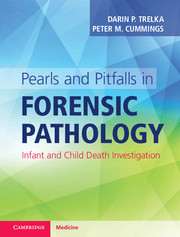
-
Select format
-
- Publisher:
- Cambridge University Press
- Publication date:
- September 2016
- June 2015
- ISBN:
- 9781139628945
- Dimensions:
- Weight & Pages:
- Dimensions:
- Weight & Pages:
You may already have access via personal or institutional login
Book description
This practical text guides the reader in infant and child death investigation from the moment the phone rings to the final signature on the death certificate. Using an easily understood conversational writing style, the text imparts up-to-date, practice-based information on approaches to death investigation, clarifying misunderstandings and supplementing training gaps. Chapters also impart personal experiences relating to policy, procedure, standards, and the anticipation of problems during death investigations. Interspersed throughout the text are procedural standards from the National Association of Medical Examiners and Centers for Disease Control and Prevention, as well as high-quality images and observations of effective administrative and management strategies for offices involved with death investigations. The book is packaged with a password, giving users online access to all text and images. Pearls and Pitfalls in Forensic Pathology: Infant and Child Death Investigation is an essential resource for medicolegal death investigators, coroners, medical examiners, forensic pathologists, forensic laboratorians and attorneys.
Contents
References
Metrics
Altmetric attention score
Full text views
Full text views help Loading metrics...
Loading metrics...
* Views captured on Cambridge Core between #date#. This data will be updated every 24 hours.
Usage data cannot currently be displayed.
Accessibility standard: Unknown
Why this information is here
This section outlines the accessibility features of this content - including support for screen readers, full keyboard navigation and high-contrast display options. This may not be relevant for you.
Accessibility Information
Accessibility compliance for the PDF of this book is currently unknown and may be updated in the future.

